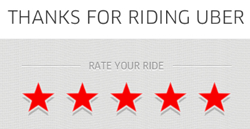 One of the great benefits of the internet has been the transparency it provides to consumers for products and services. Entire business models have been created around consumers rating the companies that provide these services such as hotels. This is often referred to as user-generated content. The website is free for users, who provide most of the content, and then the website is typically monetized by an advertising led revenue model.
One of the great benefits of the internet has been the transparency it provides to consumers for products and services. Entire business models have been created around consumers rating the companies that provide these services such as hotels. This is often referred to as user-generated content. The website is free for users, who provide most of the content, and then the website is typically monetized by an advertising led revenue model.
The business of rating hotels is nothing new, in the 1950’s Mobil created a star rating system to entice people to jump into their car and explore the United States via the newly built interstate highway system…using Mobil gas to get there of course. Non-profits such as AAA (American Automobile Association) created a diamond rating system to assist its members in finding quality hotels similar to the Mobil rating system. The issue has been that these ratings are done by a organization and not from a consumer’s point of view. Sometimes it’s easy to game the system if Mobil or AAA is rating a property vs. an individual consumer. Enter TripAdvisor.
TripAdvisor was an early entrant into the user-generated content travel space and took off like a rocket ship, it was a way for consumers to rate and rank their hotel visits. Overnight the star rating system had a formidable competitor in the form of real hotel guests that could write reviews and share their actual experiences while staying at a hotel property. Many consumers use both the star rating system and the hotel reviews written by guests to make an informed decision on what hotel to stay at.
The current system is great for consumers but what has been missing is a way for the hotel to rate the consumer on their behavior at the hotel. It’s not just hotels but any business that interacts with consumers – taxis, restaurants, etc…
I call it the “Do you know who I am” rating. If you have lived in Bombay for more than 6 months, then you have probably visited a restaurant and heard someone throw around the phrase “Do you know who I am…”, which is usually a pre-cursor to them shouting about something that has gone wrong. It gets pretty tiresome when some no-name jackass thinks they are the next Mukesh Ambani and starts to name drop. By rating the consumer, the restaurant can take extra precautions the next time the guest visits the restaurant or just decline their reservation by saying the restaurant is full.
Seems far-fetched? Not really, Uber is a taxi service that allows cab drivers to rate their passengers. So next time when a passenger wants to book via Uber the passenger’s rating comes up on the cab drivers screen and they can accept or decline the request.
Rating a consumer has always been a challenge because most point of sale (POS) terminals didn’t have a way to capture the data. But nowadays the dedicated POS terminal is giving way to smart phones and tablets that can allow companies to design what information they want to capture on the device. An example of this is Square which is a credit card payment processor that has an iPad app that turns any iPad into a POS terminal, they could potentially add a feature to rate a consumer as well.
I expect more and more business to start capturing a consumers behavior and turn it into a quantifiable rating. However, I don’t expect companies to start declining business because of a consumers rating, rather I would expect businesses to treat the consumer with extra care and caution.

